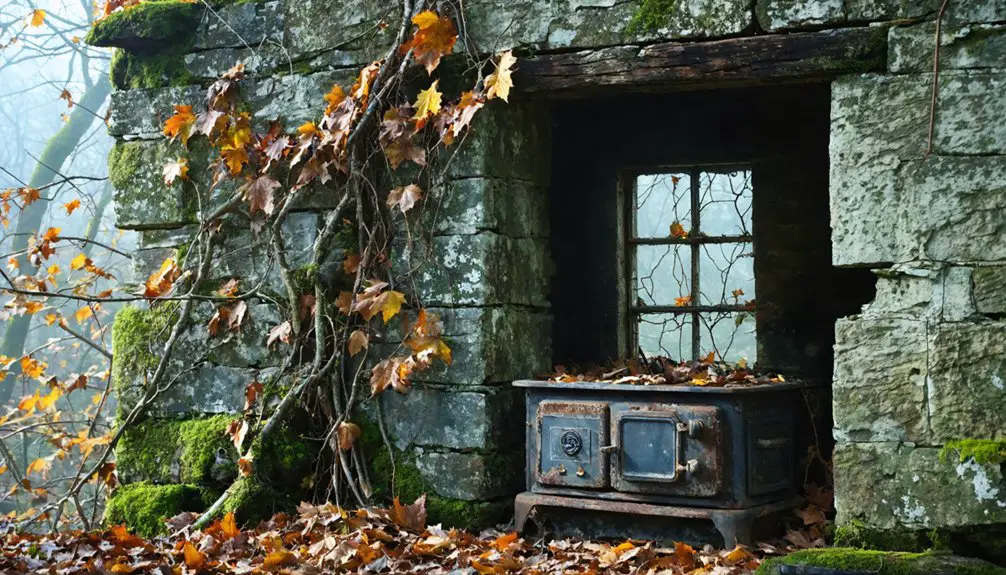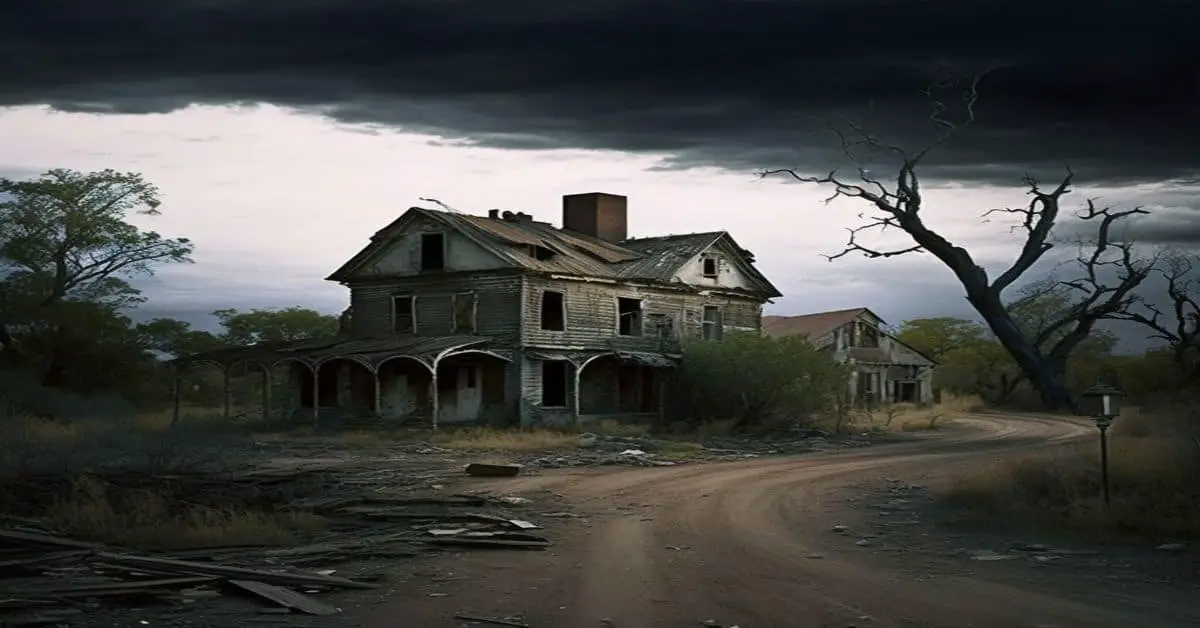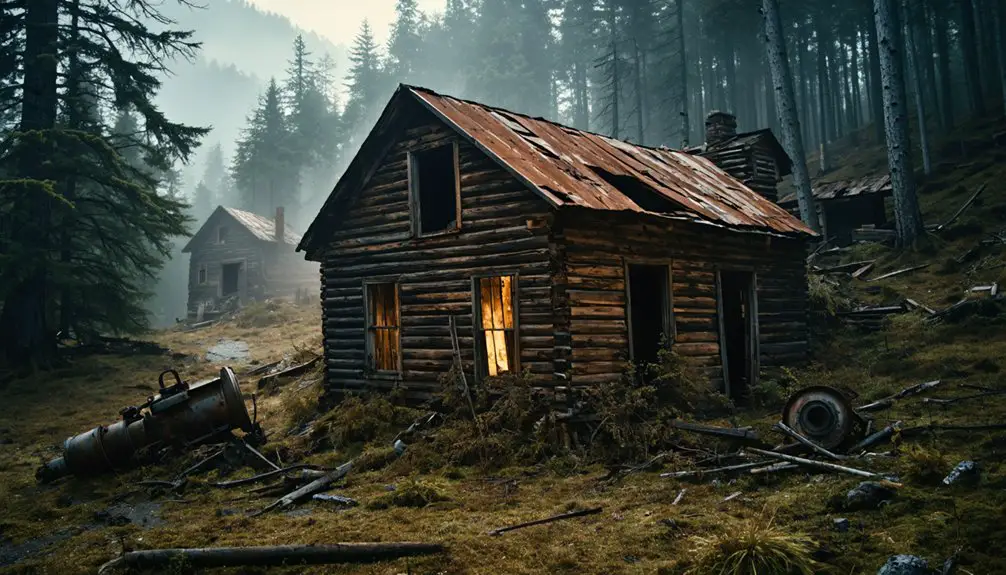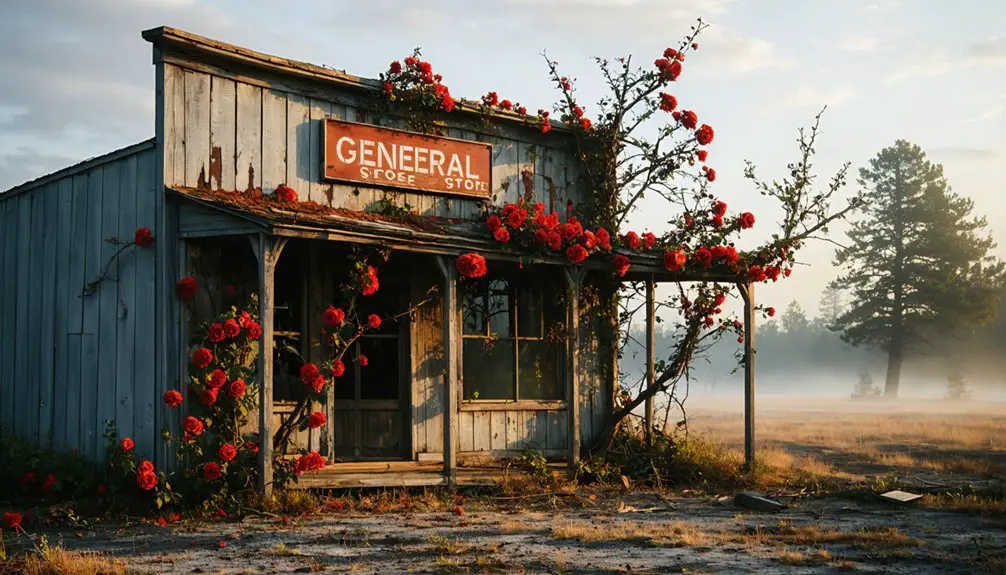You’ll discover the haunting remains of Mertens Orchard, an ambitious 1900s investment scheme that transformed 3,000 ten-acre lots into Maryland’s most intriguing ghost town within Green Ridge State Forest. Today, you can explore abandoned homesteads, rustic chimneys, and hidden cemeteries along 50 miles of hiking trails. The forest’s historic remnants include the 1,707-foot Stickpile Tunnel and forgotten rail routes. As night falls, local legends whisper of mysterious encounters near these century-old ruins.
Key Takeaways
- Green Ridge State Forest contains remnants of Mertens Orchard’s failed 1918 development, including abandoned homesteads, chimneys, and historic ruins.
- The historic Carroll Chimney and scattered foundation ruins serve as visible markers of the area’s former settlements.
- Visitors can explore over 3,000 abandoned ten-acre lots originally marketed as investment properties with views rivaling Pike’s Peak.
- Hidden cemeteries and burial grounds of early settlers dot the landscape, offering glimpses into the region’s past inhabitants.
- Geocaches mark significant historical sites throughout the forest, helping visitors locate and explore abandoned settlement remains.
The Lost Apple Empire: Rise and Fall of Mertens Orchard
The Mertens legacy took shape as they subdivided the land into over 3,000 ten-acre lots, selling them nationwide as investment properties.
You’ll find their marketing genius in how they leveraged Point Lookout’s stunning vistas, claiming it rivaled even Pike’s Peak.
Despite this orchard expansion and clever promotion, their empire crumbled by 1918. The grand experiment ended in bankruptcy, leading to abandonment until 1931, when Maryland transformed these lands into what you now know as Green Ridge State Forest.
Today, visitors can explore remnants of this history while enjoying fifty miles of paths perfect for hiking and mountain biking throughout the former orchard lands. The historic Oldtown Road, built in 1755 during the French and Indian War, runs through parts of the former orchard property.
Haunted Rails: The Mystery of Stickpile Tunnel
Deep within the folds of Maryland’s rugged terrain lies Stickpile Tunnel, a 1,707-foot engineering marvel carved through solid rock in 1906.
You’ll find this abandoned railway passage nestled in the Paw Paw bends area, where it once served as a crucial transportation link for the Western Maryland Railway until 1975. The railway built the tunnel to bypass a challenging bend in the Potomac.
Local Stickpile legends tell of a darker history – a hobo’s tragic end beneath a pile of sticks nearby gave the tunnel its name. Visitors can reserve campsites through Recreation.gov for overnight stays.
A grim tale echoes through time – the tunnel’s name forever haunts the spot where a wandering soul met his fate.
Today, you can explore this historic tunnel‘s concrete arch portals and timber-supported interior, though finding the entrances can prove challenging.
The National Park Service now preserves this piece of railway heritage, alongside the adjacent Stickpile Hill campsite where you’ll find seasonal water, picnic facilities, and a base for tunnel exploration through the surrounding wilderness.
Conservation Corps and POWs: Shaping the Forest
While most visitors to Green Ridge State Forest today see a thriving woodland ecosystem, you’ll find the landscape was shaped by two distinct groups during the 1930s and 1940s – the Civilian Conservation Corps and German prisoners of war.
The CCC contributions transformed this once-degraded landscape, starting with Company 324 in 1933, followed by the African American Company 335. You can still see their legacy in the roads, trails, and fire control systems they built. The dedicated workers maintained 50 miles of forest roads while combating wildfires and conducting rescue missions.
When WWII arrived, German POWs took up residence in the former CCC camp, providing essential labor by cutting pulpwood and picking apples in local orchards from 1944 to 1945. These prisoners were among the 500 POW camps established across America during World War II.
Together, these two groups helped restore the forest’s health while supporting the region’s economy during challenging times – their work laying the foundation for the recreational paradise you explore today.
Hidden Homesteads and Forgotten Cemeteries
Beyond the legacy of the CCC and POWs, Green Ridge State Forest harbors a rich tapestry of abandoned settlements and burial grounds.
As you explore the forest’s remote corners, you’ll discover rustic ruins from the Mertens’ ambitious “Largest Apple Orchard in the Universe” project, which ended in bankruptcy by 1918. During hikes through the area, visitors can find old chimneys and geocaches that mark these historical sites. Near the Paw Paw Tunnel, workers’ settlements once housed the laborers who laid six million bricks during its construction.
Hidden graves and forgotten cemeteries dot the landscape, marking the final resting places of early settlers and orchard workers.
The historic Carroll Chimney, a remnant of an 1836 steam-powered sawmill, stands as a reflection of the land’s industrial past.
- Discover abandoned homestead foundations, most visible during winter months when leaves have fallen
- Explore the scattered remains of early 19th-century milling operations
- Visit the Carroll Chimney, connected to the last surviving Constitution signers
- Search for hidden family cemeteries, many lacking proper markers or maintenance
Natural Wonders Along the Potomac
Following the winding path of Maryland’s most dramatic river corridor, Green Ridge State Forest‘s 46,000 acres showcase nature’s grandeur along the Potomac River.
You’ll discover diverse river ecosystems where Fifteen Mile Creek and Sideling Hill Creek merge with the mighty Potomac, creating prime fishing spots and wildlife habitats.
The forest’s elevated ridges offer spectacular scenic hiking opportunities, with overlooks providing sweeping views of the river valley below. At 926 feet elevation, the ridges provide some of Maryland’s most dramatic vantage points.
You’ll cross historic Western Maryland Railway bridges that span the Potomac, while the C&O Canal Towpath guides you through the southeastern edge.
The mixed oak forest, now 110 years old, cradles these waterways in a pristine setting where you can spot native wildlife, from deer to migratory birds, thriving in their natural habitat along the river’s edge.
Trail Guide to Abandoned Railway Routes
You’ll find the historic Western Maryland Railway‘s main access points marked by remaining infrastructure like the gated Stickpile Tunnel and the towering railroad bridge crossing the Potomac River.
When exploring these abandoned rail corridors, stay on designated trails and respect posted barriers, as many original structures are now off-limits for safety reasons. Little Orleans bar, Bill’s Place, serves as a popular rest stop for hikers and trail enthusiasts exploring the area.
The Green Ridge Trail offers the safest way to experience these railway remnants, following the old grade for nearly 20 miles between Lock 58 and Lock 67 along the C&O Canal Towpath.
Historic Rail Access Points
While exploring Green Ridge State Forest‘s abandoned railway routes, you’ll discover a network of historic rail access points that once served as vital transportation hubs in the late 1800s.
The rail preservation efforts highlight the historical significance of landmarks like Stickpile Tunnel, built by Western Maryland Railway to bypass Potomac River bends, and Green Ridge Station, which supported the region’s thriving apple orchards.
These remnants tell the story of Maryland’s industrial past and the communities that vanished after the rail era.
- Visit the abandoned railroad bridge crossing the Potomac River for dramatic views and engineering insights
- Explore Indigo Tunnel, a vital freight route until its 1975 closure
- Stop at Bill’s Place in Little Orleans, a historic gathering spot for rail workers
- Follow the potential Western Maryland Rail Trail extension through former rail corridors
Safety Along Former Tracks
To safely navigate Green Ridge State Forest’s abandoned railway routes, visitors must understand the unique hazards these historic trails present.
You’ll encounter uneven surfaces, loose stones, and potentially unstable bridges that require careful inspection before crossing. Trail hazards intensify during wet conditions, with moss-covered tunnels and leaf-strewn paths concealing dangerous obstacles.
Essential safety measures include obtaining required permits, staying on designated trails, and checking with Green Ridge Headquarters for current conditions.
Don’t rely solely on GPS – carry detailed maps and a compass, as cell reception is limited. Watch for structural concerns in tunnels like Stickpile, which are typically gated for protection.
Be mindful of seasonal flooding near creek crossings and maintain awareness of wildlife, especially in densely forested sections of former rail corridors.
Tales and Legends of Green Ridge After Dark

If you’re exploring Green Ridge State Forest after sunset, you’ll encounter the haunting legacy of the Stickpile Tunnel, where a homeless man’s tragic death in 1906 sparked decades of ghostly railway tales.
You’ll hear whispers of mysterious activities and unexplained sounds echoing through the abandoned Western Maryland Railway tunnels, which remain heavily gated to this day.
The forest’s dense canopy and remote cemeteries, including the historic Brinkman-Rine burial ground, amplify the eerie atmosphere that has fueled countless local ghost stories since the railway’s abandonment in 1975.
Mysterious Tunnel After Hours
As darkness descends on Green Ridge State Forest, the heavily gated Stickpile Tunnel transforms from a historic railroad relic into the subject of local folklore and mysterious tales.
Built in 1906 for the Western Maryland Railway, the tunnel’s robust metal gates now stand as silent guardians, fueling speculation about what lies beyond. The tunnel earned its name from a tragic discovery of a homeless man’s body beneath a pile of sticks, adding to its eerie reputation.
While daytime reveals its practical railroad history, nighttime brings whispers of unexplained phenomena and secretive operations.
- Local legends tell of strange noises echoing from within after sunset
- The tunnel’s extreme fortification sparked rumors of classified post-railroad uses
- Unexplained shadows and sounds contribute to its haunted reputation
- Its connection to the abandoned ghost town enhances its mysterious allure
Haunted Railroad Tales Persist
Beyond the haunting confines of Stickpile Tunnel, the abandoned Western Maryland Railway line harbors darker tales that echo through Green Ridge State Forest after nightfall.
You’ll discover a rich tapestry of local legends surrounding railroad spirits, with stories of workers who perished during the line’s construction and operation still lingering in the wilderness.
Near the old rail beds, visitors report ghostly apparitions resembling early 20th-century workers, accompanied by phantom train whistles and inexplicable footsteps on long-removed tracks.
The Brinkman-Rine Cemetery and dozens of other historic burial grounds dotting the forest amplify these supernatural accounts.
Since the railway’s removal in 1975, these stories have only grown stronger, intertwining with the memories of the ghost town’s former residents and the silent remnants of Maryland’s railroad history.
Moonlit Forest Ghost Stories
When darkness falls over Green Ridge State Forest, you’ll encounter a rich tapestry of supernatural tales that have captivated locals and visitors for generations.
The moonlit whispers of spectral shadows weave through the trees, from mysterious guttural howls to the haunting screams of shapeshifting creatures. You might glimpse ghostly apparitions along secluded paths or hear childlike voices echoing through the wilderness after dusk.
- Listen for the low, primal howls that hunters have reported, particularly during autumn nights
- Watch for the legendary dark-haired creature known to chase intruders on two legs or four
- Experience the eerie atmosphere near abandoned structures, including the infamous Green Ridge Tunnel
- Join guided ghost tours to safely explore these supernatural locations while preserving their mystique
Seasonal Activities in Maryland’s Largest State Forest
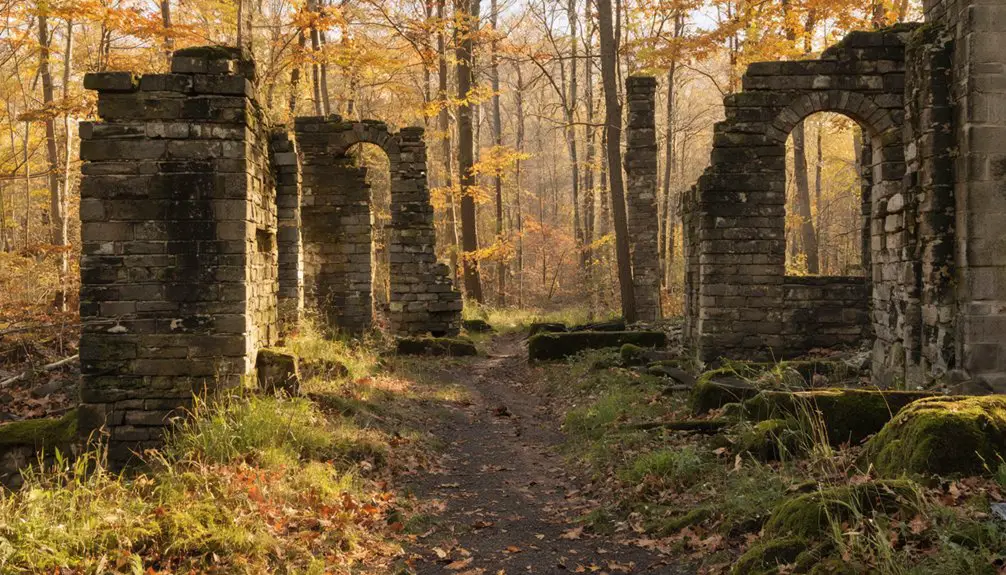
Throughout the year, Green Ridge State Forest offers diverse recreational opportunities across its sprawling 49,000 acres of Appalachian wilderness.
Nestled in the Appalachian wilderness, Green Ridge State Forest invites outdoor enthusiasts to explore its vast recreational landscape.
You’ll find prime fishing seasons at the Potomac River, where bass and catfish await, while designated catch-and-release zones at Sideling Hill Creek and other waterways provide year-round angling action.
Trail maintenance guarantees safe passage on over 50 miles of paths, from easy loops to challenging routes like the Twin Oaks Pine Lick Loop.
You can explore the backcountry on foot, bike, or horseback, with nearly 100 dispersed camping sites available for overnight stays.
The forest’s seasonal charm peaks during spring’s put-and-take trout fishing and fall hunting seasons, while winter offers solitude along the C&O Canal Towpath.
Bond’s Landing provides river access, though you’ll need to watch for strong currents.
Frequently Asked Questions
Are There Any Dangerous Wildlife Encounters Reported in Green Ridge State Forest?
Want to know about wildlife risks? You’ll find few documented dangerous encounters at Green Ridge. While bears and snakes exist, maintaining wildlife safety and encounter awareness generally prevents serious incidents.
Can Visitors Metal Detect Near the Abandoned Homestead Sites?
You can’t metal detect near abandoned homestead sites due to strict DNR regulations protecting historical relics. You’ll need permits for designated areas away from these protected cultural locations.
What Survival Gear Is Recommended for Overnight Camping in the Forest?
Pack your survival essentials: waterproof tent, 30-40°F sleeping bag, first aid kit, navigation tools, fire starter, water filter, and cookware. Follow this camping checklist to stay safe in Maryland’s rugged wilderness.
Are There Guided Tours Available Specifically for Photographing Ghost Town Ruins?
You won’t find official photography workshops or guided excursions for ghost town ruins. You’ll need to explore independently using the forest’s self-guided driving tour and obtain any necessary vehicle permits.
Which Months Have the Least Crowds for Exploring the Historic Sites?
You’ll find the most solitude during December through February, when off-peak visits coincide with winter’s harsh seasonal weather. March and early April also offer quieter exploration before spring crowds arrive.
References
- https://www.youtube.com/watch?v=CIsNOFvIcjk
- https://dnr.maryland.gov/forests/pages/publiclands/greenridge/information.aspx
- https://www.chesapeakefamily.com/spooky-maryland-hikes/
- https://en.wikipedia.org/wiki/Green_Ridge_State_Forest
- http://www.mountaindiscoveries.com/stories/ss2003/landofliving_plain.html
- https://dnr.maryland.gov/centennial/pages/centennial-notes/pointlookout.aspx
- https://gaptrail.org/amenities/green-ridge-state-forest/
- https://irighti.typepad.com/little_orleans_2008/green-ridge-state-forest-.html
- https://wvculture.org/wp-content/uploads/2021/03/Western-maryland-railway-right-of-way.pdf
- https://www.riverexplorer.com/details.php?id=881
